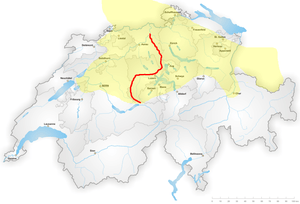High Alemannic German
| High Alemannic | |
|---|---|
| Hochalemannisch | |
| Native to |
Switzerland Germany: Baden-Württemberg Austria: Vorarlberg Liechtenstein France: Haut-Rhin |
| Latin (German alphabet) | |
| Language codes | |
| ISO 639-3 | – |
| Glottolog | None |
|
Geographical spread of High Alemannic dialects; marked in red is the Brünig-Napf-Reuss line | |
High Alemannic is a dialect of Alemannic German and is often considered to be part of the German language, even though it is only partly intelligible to non-Alemannic speakers.
Language area
The High Alemannic dialects are spoken in Liechtenstein and in most of German-speaking Switzerland (Swiss Plateau), except for the Highest Alemannic dialects in the Swiss Alps and for the Low Alemannic (Basel German) dialect in the North West.
Therefore, High Alemannic must not be confused with the term "Swiss German", which refers to all Alemannic dialects of Switzerland as opposed to Swiss variant of Standard German, the literary language of diglossic German-speaking Switzerland.
In Germany, High Alemannic dialects are spoken in Southern Baden-Württemberg, i.e. the Markgräflerland and in the adjacent area south of Freiburg im Breisgau up to the Black Forest (Schönau). It is also spoken in the southern Sundgau region beyond the Upper Rhine, which is part of Alsace, France. In Vorarlberg in Western Austria, a form of High Alemannic is spoken around the Rheintal as well.
Subdivision
High Alemannic is traditionally subdivided in an Eastern and Western language area (Sprachraum), marked by the Brünig-Napf-Reuss line isogloss crossing the Swiss cantons of Aargau and Lucerne (Luzern). Eastern High Alemannic (for instance Zurich German) and Western High Alemannic German (for instance Bernese German) differ in pronunciation of diphthongs and in pluralization.
Features
The distinctive feature of the High Alemannic dialects is the completion of the High German consonant shift, for instance chalt [xalt] 'cold' vs. Low Alemannic and standard German 'kalt' [kʰalt].
